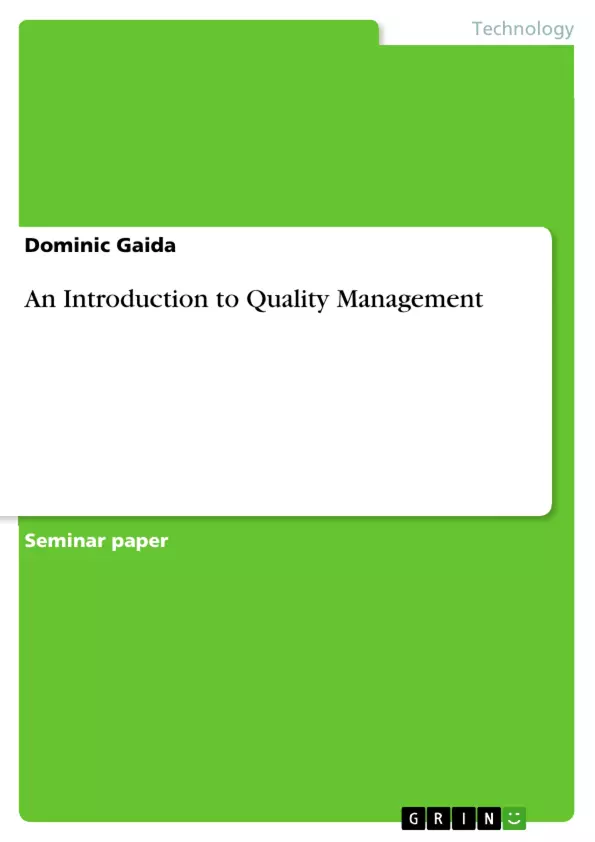„Quality exists, when the price is long forgotten!“
With these words the co-founder of the tradition enterprise of Rolls Royce, Frederick Henry Royce, was quoted.
Quality ingrains the good reputation. The one who get this rep will be open the floodgates but if you lost it you go down under very fast or you have to try hard to re-establish your tattered reputation.
Quality is brainwork. Regarding to the corporate strategy quality is a typical Top-Down-Task. This strategy can only be successful when the Top-Management is disposed to put it into practice. In corporate culture thinking of quality however each co-worker is part of these one and because of that it has a typical Bottom-Up-Process characterized with a sustainable implementation.
In today's time affected by cut-throat competition and consequential customer orientation corporations attach great importance to quality.
How hard the customer penalizes quality-shortfalls a study of the White House Office of Customer Affairs impressively set forth. In these study 90 from 100 customers, who were dissatisfied with the condition of the goods will from now on avoid this product. It is remarkable that only about 4% of the dissatisfied customers complain about the quality directly to the manufacturer. Unfortunately every one of these dissatis-fied customers will pass his displeasure about the quality to at least nine further potential customers.
Quality might be from existential importance for a company. In the competition still increasing in sharpness around shares of the market only the enterprises will keep up which have a integrated quality thinking and acting.
[...]
Table of Contents
- Introduction
- Total Quality Management
- Precursor of the TQM
- Deming-Approach
- Juran-Approach
- Feigenbaum-Approach
- Crosby-Approach
- Ishikawa-Approach
- The Road to TQM
- The Idea of TQM
- Philosophy of TQM
- Customer-oriented
- Employee orientation
- Process-oriented
- Results-oriented
- Peculiarity of the TQM
- Success story for the implementation of TQM
- Efficiency and cost aspects of the TQM
- Precursor of the TQM
- Quality management system
- Basic principles of QMS
- Requirements of QMS
- Structure of the QMS
- Process-oriented QMS
- Processes with high repetition
- Processes with low repetition
- Documentation of the QMS
- Standardization and certification
- Standardization
- Certification
- Implementation of the QMS
- Integrated management system
- The interrelation between the Environmental management and the QMS
- Basic principles of QMS
- Costs and benefit of the QM
- Profitability analysis
- Quality controlling
- Idea and objectives
- Functions
- The challenge of change
Objectives and Key Themes
This text aims to provide a comprehensive overview of Total Quality Management (TQM) and Quality Management Systems (QMS), exploring their historical development, principles, implementation, and economic implications. It examines various approaches to quality management, analyzes the role of customer and employee orientation, and discusses the challenges of implementing change within organizations.
- The evolution and different approaches to Total Quality Management (TQM).
- The principles and structure of effective Quality Management Systems (QMS).
- The importance of customer and employee orientation in achieving quality goals.
- Cost-benefit analysis of implementing and maintaining a QMS.
- The challenges of organizational change inherent in the adoption of TQM.
Chapter Summaries
Chapter 1: Introduction introduces the concept of quality and its importance in today's competitive business environment.
Chapter 2: Total Quality Management discusses the shift in understanding of quality management, focusing on the customer-centric approach of TQM and exploring the contributions of various pioneers like Deming, Juran, Feigenbaum, Crosby, and Ishikawa. It delves into the philosophy, peculiarities and implementation success stories of TQM.
Chapter 3: Quality Management System details the basic principles, requirements, and structure of a QMS, examining both process-oriented approaches for high and low repetition processes. It explores the importance of documentation, standardization, certification, and the implementation process itself. The integration of environmental management into a QMS is also discussed.
Chapter 4: Costs and Benefit of the QM examines the economic aspects of quality management, including profitability analysis and the role of quality controlling in coordinating and monitoring quality-related activities.
Keywords
Total Quality Management (TQM), Quality Management System (QMS), Quality Control, Customer Orientation, Employee Orientation, Process Orientation, Continuous Improvement, Cost-Benefit Analysis, Organizational Change, Standardization, Certification.
- Citation du texte
- Diplom-Betriebswirt (FH) Dominic Gaida (Auteur), 2006, An Introduction to Quality Management, Munich, GRIN Verlag, https://www.grin.com/document/122197



